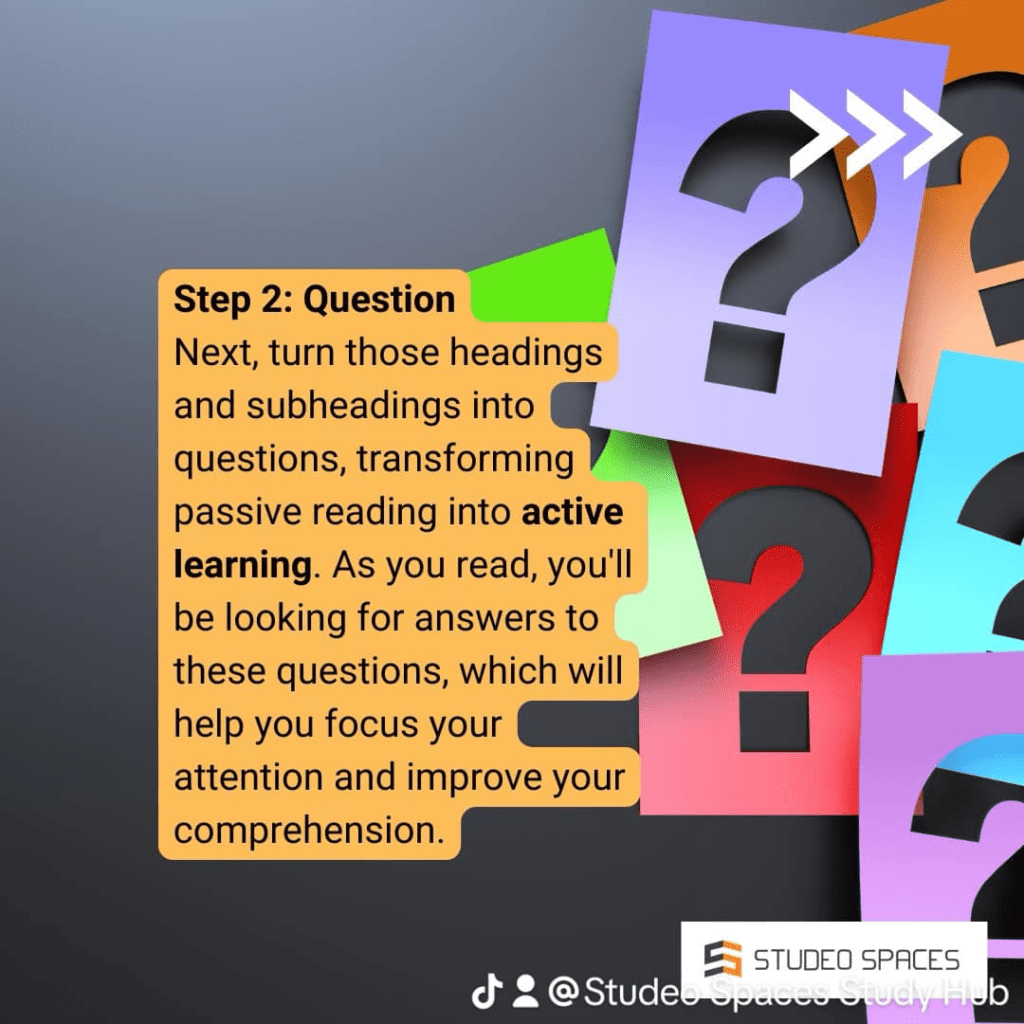
Unleash Your Learning Potential: Mastering the SQ3R Method for Academic and Exam Success: The journey of learning, whether for completing a college course or conquering the formidable board exams, demands more than passively reading materials. It requires an active, strategic approach to processing and retaining information. Enter the SQ3R method, a powerful reading and study technique to enhance comprehension and memory. This blog post will delve into the depths of the SQ3R method, exploring its principles, practical applications, and how it can be your secret weapon for achieving academic excellence and board exam success.
What is the SQ3R Method?
The SQ3R method, developed by educational psychologist Francis P. Robinson in the 1940s, is a structured approach to reading comprehension that involves five key steps: Survey, Question, Read, Recite, and Review. It’s not just about passively absorbing words; it’s about actively engaging with the material to deepen understanding and promote long-term retention.

Here’s a breakdown of each step:
- Survey (S): Before diving into the text, take a few minutes to get an overview of the material. This is about familiarizing yourself with the landscape before embarking on a journey through the text.
- Read the introduction and summary.
- Examine headings and subheadings. These provide a roadmap of the main topics and concepts.
- Look at visuals such as pictures, charts, and graphs.
- Note any bolded or italicized words.
- Skim the chapter’s conclusion and study questions.
- Please note each paragraph’s first and last sentences, often highlighting the main idea.
- This initial survey helps to provide a framework for the information you will be reading.

- Question (Q): Transform headings and subheadings into questions. For example, if a heading reads “The Impact of Climate Change,” turn it into a question: “What is the impact of climate change?”.
- This step is about creating a purpose for reading. Instead of passively reading, you actively search for answers to your questions.
- Generate broader questions like, “What is this section about?” or “How could this information be useful to me?”.
- This questioning approach is similar to elaboration, which connects new knowledge to existing knowledge.

- Read (R): Engage with the text actively while searching for the answers to the questions you have created.
- Focus on identifying the main ideas and supporting details.
- Pay attention to transition words such as “next,” “for example,” and “in contrast” to understand the flow of ideas.
- Make notes, summarize key points, and paraphrase information in your own words rather than copying directly from the text.
- Highlight only the most essential points, as excessive highlighting can make distinguishing main ideas from supporting details difficult.
- Keep the questions you have generated in mind when you read, making your reading experience more active.

- Recite (R): After reading a section or chapter, recall what you have learned in your own words.
- This can be done aloud or in writing, but the key is actively retrieving the information from memory.
- Answer the questions you created earlier or those at the end of the chapter. If you can’t answer them, return to the text to review and take further notes.
- This step is crucial for solidifying your understanding and transferring information to long-term memory. It is a form of retrieval practice that helps you check for comprehension.

- Review (R): After studying new material, conducting an overall review within 24 hours is essential for maximum comprehension and memory.
- Revisit the material after some time, ideally within 24 hours, to reinforce your learning. You can lose much of what you have learned if you do not review it within the next day.
- Please review the questions you created earlier and try to answer them without looking at the text. This will help you identify any areas that need further attention.
- Review may involve checking the answers or rereading the text, depending on when you review.

Why is SQ3R Effective?
The effectiveness of the SQ3R method stems from its ability to engage the reader actively in the learning process. By combining surveying, questioning, reading, reciting, and reviewing, SQ3R taps into several key cognitive processes that promote better understanding and retention:
- Organization: The survey step helps you create a mental framework for the information before you begin reading. Organization is key for understanding and retaining information.
- Active Engagement: Generating questions and searching for answers transforms reading from a passive activity into an active pursuit.
- Elaboration: By creating questions, you connect new information with existing knowledge, and if they’re answering those questions during the reading phase, they are actively elaborating on the material.
- Retrieval Practice: Reciting the information in your own words is a form of retrieval practice, a powerful strategy for strengthening memory.
- Spaced Repetition: The review step reinforces your learning over time, a key element for long-term retention.
Adapting SQ3R for Different Learning Styles and Situations
While the core principles of SQ3R remain consistent, it’s essential to recognize that different individuals may find variations that suit their learning styles better. Some might find that creating elaborate questions works best, while others find that summarizing what they read is most effective. The SQ3R method is a flexible framework, not a rigid set of rules. Here are some ways to adapt it:
- Flexibility is key: You don’t have to follow all the steps. Use what works best for you.
- Tailor Your Questions: Adjust the types of questions you generate based on your needs and the material’s complexity. You can ask general questions to understand the content or more specific questions to address particular aspects.
- Choose Your Method of Recitation: Find a method of recitation that suits you, whether speaking aloud, writing notes, or creating mind maps.
- Vary Your Review: Try different review techniques like rereading, summarizing, or teaching the material to someone else.
Beyond SQ3R: Exploring the 3R Approach
Recent research suggests that the core of SQ3R, the 3Rs of read, recite, and review, can be a highly effective method. Some experts propose that the survey and question components can be challenging to master and assess, as their effectiveness depends heavily on the quality of the questions. The 3R approach is quick to teach, efficient during study, and effective for learning.
Enhancing Your Study Strategy with SQ3R
The SQ3R method is more than just a reading technique; it’s a comprehensive study strategy that can transform how you learn and approach exams. Here are some tips on how to maximize the effectiveness of SQ3R for both academic studies and board exam preparation:
- Create a Study Schedule: Integrate the SQ3R method into your study routine. Plan your study sessions so that you can dedicate time to each step.
- Be Selective When Highlighting and Note-Taking: Focus on essential points and paraphrase or summarize in your own words.
- Use Marginal Notes and Summaries: Write down questions or your responses to questions in the margins. Use summaries to condense information.
- Relate New Material to What You Already Know: When you study a chapter, try to link new facts, terms, and concepts with information you already know.
- Incorporate Different Learning Techniques: Use visuals, videos, or discussions to complement your SQ3R reading.
- Practice Regularly: The more you practice the SQ3R method, the more natural and effective it will become.
The Power of Review and SQ4R
Remember, consistent review is critical for success. Please review what you’ve read within 24 hours to help you remember it, and continue to review it frequently until you are comfortable with the material. Additionally, you may want to consider a variation called the SQ4R method, which adds another “R” to the process, which could be “Relate,” “Write,” “Record,” “Reflect,” or “Respond,” adding further depth to the method.
Does Research support SQ3R?
While the theoretical foundations of SQ3R are robust, the empirical research supporting its effectiveness is mixed. This is likely due to inconsistencies in how the method is applied. The 3R method (Read, Recite, Review) has a more solid research foundation. The key to success with SQ3R lies in using the method appropriately and consistently, ensuring active engagement with the text, and regularly reviewing the material.
Conclusion
The SQ3R method provides a structured approach to reading comprehension that can significantly enhance your study habits. By actively engaging with the text through surveying, questioning, reading, reciting, and reviewing, you can improve your understanding, retention, and, ultimately, your performance in your academic pursuits and board exams. While it may take some practice to master, the potential benefits are immense. Whether you stick to SQ3R Method, or streamline it to 3R, tailor it to your learning style and study requirements. With consistent practice, SQ3R can become an invaluable tool in your academic journey and help you achieve the success you deserve.
Frequently Asked Questions About the SQ3R Method
What is the SQ3R method, and what does each step entail?
The SQ3R method is a reading comprehension strategy designed to enhance understanding and retention of written material. It consists of five steps: Survey (skimming the text to get an overview), Question (generating questions about the content), Read (actively reading to find answers), Recite (recalling and explaining the content in your own words), and Review (revisiting the material to reinforce learning).
How do you effectively survey a text according to the SQ3R method?
Surveying involves scanning the material to grasp its structure and main ideas before diving into detailed reading. This includes looking at titles and headings, visual aids like pictures or graphs, introductory and concluding paragraphs, and any questions or summaries included in the text. The goal is to create a mental framework of the material.
Why is generating questions considered a key step in the SQ3R process?
Formulating questions transforms reading from a passive activity to an active one. By turning headings into questions or creating general inquiries about the text (e.g., “What is this about?,” “How is this relevant to me?”), readers create a purpose for their reading. Searching for answers to these questions facilitates deeper engagement and comprehension.
What does the ‘Recite’ or ‘Recall’ step of the SQ3R method involve and why is it important?
The ‘Recite’ step requires you to explain what you have just read in your own words, orally or in writing. It’s crucial because this process of active recall helps solidify the information in your long-term memory. It checks your understanding, goes beyond simply reading, and allows you to process and synthesize the material actively.
How does the ‘Review’ step contribute to the overall effectiveness of SQ3R?
The review step is crucial for long-term retention. It involves reviewing the material, trying to answer the questions you generated earlier, and reinforcing your understanding of the main ideas. Reviews are more effective when they happen soon after reading, ideally within 24 hours, to prevent significant memory loss of the studied material.
Is the SQ3R method universally agreed upon and supported by empirical research?
While the underlying principles of SQ3R align with effective learning strategies such as elaboration, organization, and retrieval practice, there isn’t complete consensus on its application. Studies have shown mixed results, likely due to variations in how people implement each step. Some research indicates that the core elements of Read, Recite, and Review are practical while the Survey and Question steps might be more challenging to execute effectively.
What is the ‘4th R’, and how does it expand upon the SQ3R method?
The “4th R” expands upon the basic SQ3R model with variations such as: Relate, connecting new information to existing knowledge or personal experiences to deepen understanding; wRite, involving note-taking, outlining, or summarizing to reduce the info; Record, highlighting or annotating the text to identify key ideas for later review; Reflect, which asks you to think about the material’s significance; and Respond, to seek and note answers to questions in the margins.
How can the SQ3R method, or its core principles, be adapted for more effective learning?
If the SQ3R method doesn’t work as intended, focus on its core elements – actively reading with questions, reciting or recalling key information, and spaced review. You can choose one of the additional “R” methods. Ensure you’re creating high-quality, elaborative questions, that your initial survey genuinely assists with the organization of understanding, and that your recitation is an active retrieval exercise. You might consider dropping the study and question aspects and focusing solely on the read, recite, and review components as an efficient and effective method if you have difficulty mastering the question component.
SQ3R Method Glossary of Key Terms
- Active Reading: Engaging with text in a way that promotes understanding, critical thinking, and retention rather than passively absorbing words.
- Elaboration: The process of connecting new information to existing knowledge, helping to build a deeper understanding and promoting memory.
- Empirical Support: Evidence derived from research, experiments, or observations used to validate claims or theories.
- Free Recall: The ability to retrieve information from memory without prompts or cues, often tested by simply asking a learner to record as much as possible about the material.
- Inference Questions: Questions that require a reader to use details within a text and prior knowledge to draw a conclusion that is not explicitly stated.
- Retrieval Practice: Actively recalling information from memory, a powerful technique to enhance material retention over time.
- Reread: The simple act of going back over a text a second or third time.
- Spaced Repetition: A learning technique that involves reviewing information at increasing intervals to strengthen long-term memory and retention.
- SQ3R: A reading comprehension method comprised of five steps: Survey, Question, Read, Recite, and Review.
- 3R: A modified SQ3R reading method consisting of only three steps: Read, Recite, and Review.
Studeo Spaces Quick Links
- Book a Desk / Room
- Location
- Rates
- Features and Amenities
- Business Hours
- Private Rooms
- Latest News
Stay Connected
- Facebook: https://www.facebook.com/StudeoSpaces
- Tiktok: https://www.tiktok.com/@studeospaces
- Youtube: https://www.youtube.com/@StudeoSpaces






